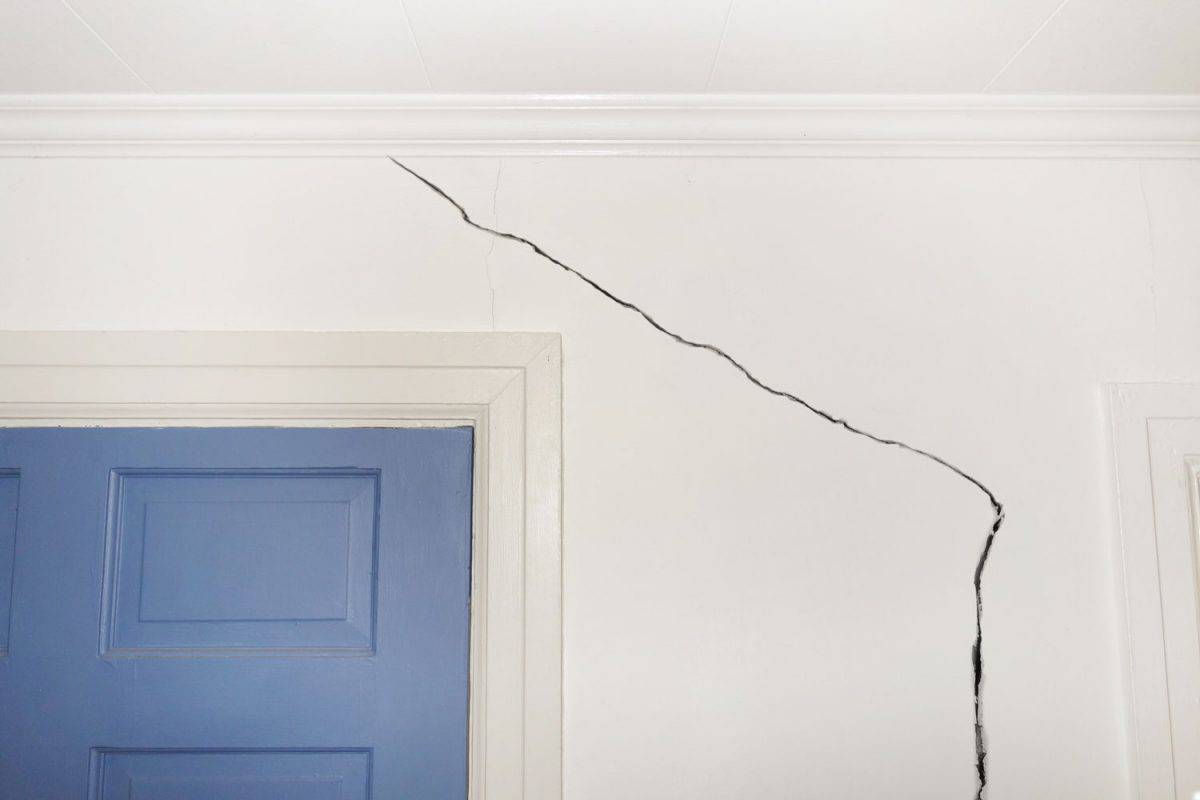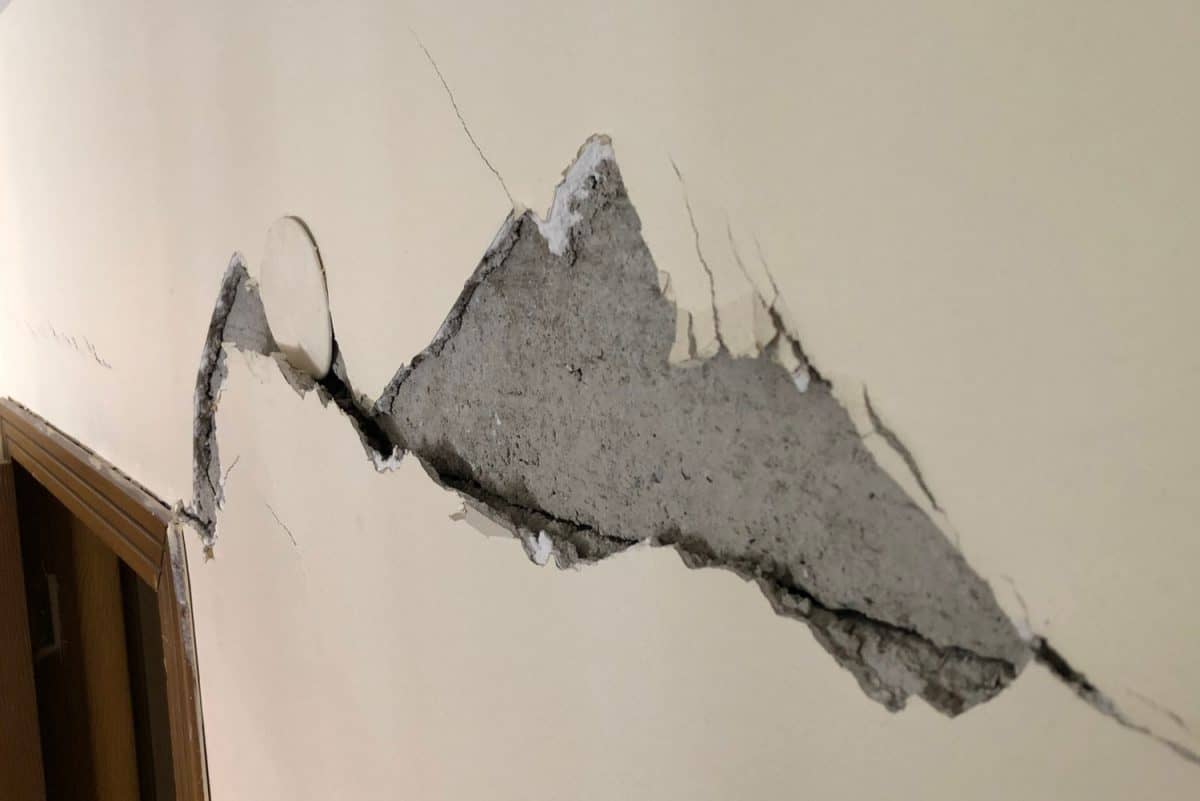Big or small, cracks in your wall are a fair reason for you to be concerned. You've probably wondered why your drywall is cracking, what the possible causes are, how worried you should be, and if it's something you can fix or prevent. We've done the research so you can figure out why your drywall keeps cracking and learn some actions you can take to fix or prevent it.
The majority of drywall cracks occur along seams in the drywall and are caused by stress. Stress can be caused by temperature changes making the drywall expand and contract, the house naturally settling, general wear and tear from traffic, or bending drywall thanks to nails popping out.
The best way to prevent cracks is by using high-grade materials during construction or redoing the wall completely. It's worth noting that sometimes cracks are not preventable and will naturally occur and need to be fixed.
Continue reading to learn more about why your drywall may be cracking, how big an issue it could be, and how to reduce cracking. We'll also answer some common questions you might have about drywall. Remember to call and have your home inspected any time you feel there are larger issues behind the small ones so you can get ahead on repairing them.
![Crack caused by settlement on the building foundation of the building, Why Does My Drywall Keep Cracking? [And What To Do About It]](https://uooz.com/wp-content/uploads/2021/11/Why-Does-My-Drywall-Keep-Cracking-And-What-To-Do-About-It.png)
Why Does My Drywall Keep Cracking?

In many cases, drywall cracks are the result of a normal house settling. These kinds of cracks are just where the seams in the drywall come apart and bulge. You can remedy this easily by retaping or reapplying mud to the joints.
Cracks can also occur due to temperature fluctuations. When drywall heats up, it expands, and when it cools, it contracts. Repeated expansion and contraction can cause fractures in the material itself. You can usually fill the smaller ones in with drywall mud and sand them to an even finish.
For more information about the way drywall expands and contracts, check out our article Does Drywall Expand And Contract?
You also can obviously expect some cracks in heavy traffic areas and normal wear and tear. Bumping into walls, kids' toys bouncing off of them, or even pets sliding into areas repeatedly can lead to cracks forming in your drywall.
The nails that hold the drywall up can pop out of the framing they're nailed into. The drywall sheets bulge and bend when this happens, causing the stress cracks you're likely seeing. You can avoid this by using better wood for framing or longer nails in the drywall.
Cracks that continuously expand or reoccur after repairs can be indicators of larger problems. Large cracks can be due to extreme shifts in your house's foundation. If large cracks occur quickly, cracks continue to expand, or repaired cracks continually reoccur, call an expert for a home inspection.
This can help you find and begin larger repairs before they become incredibly expensive and time-intensive.
Do Drywall Cracks Mean Foundation Problems?

Drywall cracks do not automatically mean foundation problems, but they can be an indicator. Your house will constantly settle over time, and an uneven foundation or a foundation set in soft ground will lead to uneven or quicker settling and drywall cracks. If you're seeing cracks, try to find out what kind of ground your foundation is set in. Sandy soils can often cause the house to settle faster and lead to drywall cracks.
Always keep in mind, many drywall cracks can be prevented simply by better construction. This includes the drywall installation and materials themselves but also extends to a quality foundation and framing. A better set foundation and higher quality wood framing can reduce the chances of cracks.
Any time you are concerned or a crack continually keeps coming back, it's worth it to call in an expert for an inspection. If you do have foundation problems, the longer you wait to fix them, the more expensive and time-intensive the repairs will be.
How Do you Stop Drywall Cracks from Coming Back?
There are a few ways you can help keep some drywall cracks from reappearing. Using improved construction materials during repairs is one of the best ways outside of high-quality construction and materials to start with.
Setting additives can be mixed into drywall mud to make it more malleable. What this does is add some flexibility to the joints, allowing them to compensate for expansions, contraction, and normal house settling.
Reapplying mud and tape is the best way to fix fractures if you aren't going to replace a sheet in its entirety. Remove as much of the mud and tape as you can, and then reapply with stronger materials to help hold the sheet in place better. Another tip is to properly nail in the drywall, removing nails from the corners, so they have freedom of movement if they happen to be nailed into the framing.
Sometimes, drywall cracks are simply going to occur. In these cases, it's likely you'll need to completely redo the drywall work in your home or at least for that section. Recurring drywall cracks are hints towards one of two things, either faulty construction or a larger issue such as an uneven foundation.
Having your foundation and home inspected is a good start, but redoing your drywall can solve a lot of problems if you're sure to use high-grade materials and have professionals do the installation.
How to Repair Stress Cracks in Drywall
Repairing stress cracks in drywall is a pretty simple process. You just need a few materials and tools and the knowledge of how to do it. We'll provide those here:
Tools and materials
- 5 in 1 painters tool
- Floor protection (drop cloth)
- Joint compound (spackle, drywall mud, caulk)
- Drywall taping knives
- Sanding material
Step-by-step guide for repairing stress cracks in dry wall:
- Set up drop cloth and step ladder (if necessary) under the area you'll be working.
- Open the crack further with the 5 in 1 tool (open to 1/4 inch or so).
- Rake out extra loose material.
- Apply a thin layer of mud over the crack, and then apply paper tape to the crack.
- With the taping knife, press and flatten the tape down, pressing out the mud underneath and into the crack.
- Apply a thin layer of mud over the tape and allow it to dry.
- Repeat step 6 two additional times, making sure to spread the mud evenly and going farther out each time.
- Paint and primer over the patched area to match the rest of the wall.
Following these steps is an easy way to fix cracks in drywall that occur around seams. For a great visual aid, check out this video:
Can I Use Caulk to Fix Drywall Cracks?
Caulk is a solid option for drywall repairs, namely small stress fractures, and cracks that aren't in seams. You want to use a flexible adhesive that is also suitable for moisture. Caulk is flexible and can handle normal house settling and flexing of walls due to temperature changes.
If you plan to use caulk to repair cracks, you should follow similar steps to the above section. Namely:
- Sand and wet the drywall to remove paint and excess materials.
- Apply a layer of caulk over the crack, pressing it in and spreading it evenly over the surface.
- Once it has time to cure, sand and paint over the repaired areas to match the wall around it.
Why Does My Drywall Keep Cracking
![Crack caused by settlement on the building foundation of the building, Why Does My Drywall Keep Cracking? [And What To Do About It]](https://uooz.com/wp-content/uploads/2021/11/Crack-caused-by-settlement-on-the-building-foundation-of-the-building-1200x801.jpg)
Drywall cracking is most commonly caused by stress from your house settling, temperature fluctuations, faulty construction and low-grade materials, and normal wear and tear. In most cases, drywall repairs are simple and quick projects. However, in the case of repeatedly occurring cracks, it's worth your time to call in an expert for an inspection to make sure there aren't larger problems going on.
For more information about drywall and repairs, check out these articles:
